Family name: Maundiaceae Nakai
Synonym(s): [none]
Common name(s): maundia family
*Number of genera/species: 1/1
List of genera records in GRIN-Global
fruit
Fruit a schizocarpschizocarp:
usually dry fruit splitting between two or more locules to form distinct, indehiscent, usually one seeded segments; fruit derived from a single, superior or inferior, compound ovary; compare to mericarp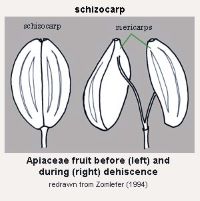 of 1–4 achenesachene:
of 1–4 achenesachene:
a dry, indehiscent, one-seeded fruit, with seed attached to pericarp at a single point, derived from a single, superior, simple or compound, one-loculed ovary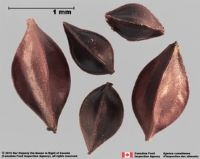 , usually falls united. AchenesAchene:
, usually falls united. AchenesAchene:
a dry, indehiscent, one-seeded fruit, with seed attached to pericarp at a single point, derived from a single, superior, simple or compound, one-loculed ovary 6–8 mm long x 2–4.5 mm wide, cylindrical, recurved beakbeak:
6–8 mm long x 2–4.5 mm wide, cylindrical, recurved beakbeak:
a usually firm, terminal appendage, sometimes tapered formed from persistent stylestyle:
formed from persistent stylestyle:
in a flower, the narrow and elongated part of the pistil between the stigma and the ovary; sometimes persisting in fruit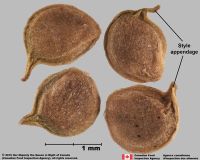 , two recurved laterallateral:
, two recurved laterallateral:
(of embryo) embryo lies along the side of the seed, generally towards one end; of, at, or from the side; in grasses, can refer to the sides adjacent to the dorsal and ventral sides
wings, with one seed. Pericarppericarp:
fruit wall or fruit coat
brown, spongyspongy:
soft, light, discontinuous but cohesive, and somewhat resilient
.
Seed and embryo likely similar to Juncaginaceae.
| Fruit | |
| Type | acheneachene: a dry, indehiscent, one-seeded fruit, with seed attached to pericarp at a single point, derived from a single, superior, simple or compound, one-loculed ovary  |
| Size range | 6–8 mm long x 2–4.5 mm wide |
| Shape(s) | cylindricalcylindrical: 3D shape—a cylinder, with parallel sides and a circular cross-section; tubular or rod-shaped |
| Texture | spongyspongy: soft, light, discontinuous but cohesive, and somewhat resilient |
| Color(s) | brown |
| Unique features | Schizocarpschizocarp: usually dry fruit splitting between two or more locules to form distinct, indehiscent, usually one seeded segments; fruit derived from a single, superior or inferior, compound ovary; compare to mericarp  of 1–4 achenesachene: of 1–4 achenesachene:a dry, indehiscent, one-seeded fruit, with seed attached to pericarp at a single point, derived from a single, superior, simple or compound, one-loculed ovary  , falling united. AchenesAchene: , falling united. AchenesAchene:a dry, indehiscent, one-seeded fruit, with seed attached to pericarp at a single point, derived from a single, superior, simple or compound, one-loculed ovary  with recurved beaks and persistent tepalstepal: with recurved beaks and persistent tepalstepal:a member of the perianth, when it cannot be differentiated into a calyx and corolla 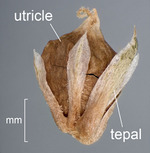 and stamens. and stamens. |
Eastern Australia.
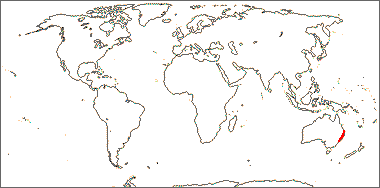
Distribution map courtesy of Angiosperm Phylogeny Website.
Baskin and Baskin 2021Baskin and Baskin 2021:
Baskin C and Baskin J. 2021. Relationship of the lateral embryo (in grasses) to other monocot embryos: A status up-grade. Seed Science Research 31 (3): 199-210. doi:10.1017/S0960258521000209; Dahlgren et al. 1985Dahlgren et al. 1985:
Dahlgren RMT, Clifford HT, and Yeo PF. 1985. The families of the monocotyledons: structure, evolution, and taxonomy. Springer-Verlag, Berlin. 520 pp.; Flora of Australia 2021+Flora of Australia 2021+:
Flora of Australia. Australian Biological Resources Study, Canberra. Accessed January 2021–March 2024. URL: http://www.ausflora.org.au; Kirkbride et al. 2006Kirkbride et al. 2006:
Kirkbride JH, Jr, Gunn CR, and Dallwitz MJ. 2006. Family guide for fruits and seeds, vers. 1.0. Accessed September 2020-January 2022. URL: https://nt.ars-grin.gov/seedsfruits/keys/frsdfam/index.cfm .; Kubitzki et al. 1990+Kubitzki et al. 1990+:
Kubitzki K et al., eds. 1990+. The families and genera of vascular plants. 7+ vols. Berlin etc.; Sokoloff et al. 2013Sokoloff et al. 2013:
Sokoloff DD, von Mering S, Jacobs SWL, and Remizowa MV. 2013. Morphology of Maundia supports its isolated phylogenetic position in the early-divergent monocot order Alismatales. Botanical Journal of the Linnean Society 173 (1): 12-45. https://doi.org/10.1111/boj.12068; Stevens 2001+Stevens 2001+:
Stevens PF. 2001+. Angiosperm Phylogeny Website Version 14, July 2017 [and more or less continuously updated since]. Accessed September 2020-2022. URL: http://www.mobot.org/MOBOT/research/APweb/; Thiele and Adams 2014Thiele and Adams 2014:
Thiele KR and Adams LG. 2014. Families of Flowering Plants of Australia. Accessed January-December 2021. URL: https://keys.lucidcentral.org/keys/v3/FFPA/key/FFPA/Media/Html/index.htm
*The number of genera and species is based on Christenhusz and Byng 2016Christenhusz and Byng 2016:
Christenhusz MJM and Byng JW. 2016. The number of known plant species in the world and its annual increase. Phytotaxa 261 (3): 201-217. https://doi.org/10.11646/phytotaxa.261.3.1, which may differ from the number of genera in GRIN-Global.